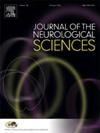West Nile virus neuroinvasive disease: Clinical characteristics and prognostic factors
IF 3.2
3区 医学
Q1 CLINICAL NEUROLOGY
引用次数: 0
Abstract
Background
In 2024, Israel experienced its largest West Nile Virus (WNV) outbreak, with 922 confirmed cases. WNV is a leading global cause of viral encephalitis. This study aimed to identify clinical features and prognostic factors associated with neuroinvasive WNV in hospitalized patients.
Methods
We retrospectively reviewed hospitalized patients with confirmed WNV at a tertiary center in Israel (January–September 2024). Patients were categorized as neuroinvasive or non-neuroinvasive. Demographic, clinical, and outcome data were analyzed. Primary outcome was 16-week mortality; secondary was functional decline (modified Rankin Scale, mRS).
Results
Of 166 hospitalized patients, 93 (56 %) had neuroinvasive WNV, primarily encephalitis (90 %). Neuroinvasive disease was linked to higher mortality (36 % vs. 13 %, p < 0.01) and worse functional outcomes (median mRS 4 ± 2 vs. 2 ± 2, p = 0.02). No significant differences in age, sex, comorbidities, or immunosuppression were found between groups. Among neuroinvasive cases, encephalitis, seizures, and autonomic dysfunction were associated with poorer outcomes. Lower pre-morbid function did not predicted greater decline. EEG in 28 encephalitis patients showed abnormalities in 71 %, mainly diffuse slowing; epileptiform activity was rare. Quantitative EEG revealed increased delta power and more frequent paroxysmal slow wave events(PSWE), which correlated with worse functional status.
Conclusions
Neuroinvasive WNV is associated with substantial morbidity and mortality. Traditional risk factors like age were not predictive of poor outcomes. Instead, clinical features such as autonomic dysfunction and novel markers like quantitative EEG abnormalities may serve as valuable prognostic tools. These findings underscore the need for improved risk stratification strategies in WNV neuroinvasive disease.
西尼罗病毒神经侵袭性疾病:临床特点和预后因素
在2024年,以色列经历了最大的西尼罗病毒(WNV)暴发,有922例确诊病例。西尼罗河病毒是病毒性脑炎的全球主要病因。本研究旨在确定与住院患者神经侵袭性西尼罗河病毒相关的临床特征和预后因素。方法回顾性分析以色列某三级医疗中心(2024年1 - 9月)确诊的住院西尼罗河病毒患者。患者分为神经侵入性和非神经侵入性。对人口学、临床和结局数据进行分析。主要终点为16周死亡率;其次是功能下降(改良Rankin量表,mRS)。结果166例住院患者中,93例(56%)为神经浸润性西尼罗河病毒,主要为脑炎(90%)。神经侵袭性疾病与较高的死亡率(36% vs. 13%, p < 0.01)和较差的功能预后(中位mRS 4±2 vs. 2±2,p = 0.02)相关。各组之间在年龄、性别、合并症或免疫抑制方面无显著差异。在神经侵入性病例中,脑炎、癫痫发作和自主神经功能障碍与较差的预后相关。较低的发病前功能并不预示着更大的衰退。28例脑炎患者脑电图异常占71%,以弥漫性减慢为主;癫痫样活动罕见。定量脑电图显示δ波功率增加,阵发性慢波事件(PSWE)更频繁,与较差的功能状态相关。结论神经侵袭性西尼罗河病毒具有较高的发病率和死亡率。年龄等传统风险因素并不能预测不良结果。相反,临床特征,如自主神经功能障碍和新的标记,如定量脑电图异常,可能作为有价值的预后工具。这些发现强调了改进西尼罗河病毒神经侵袭性疾病的风险分层策略的必要性。
本文章由计算机程序翻译,如有差异,请以英文原文为准。
求助全文
约1分钟内获得全文
求助全文
来源期刊

Journal of the Neurological Sciences
医学-临床神经学
CiteScore
7.60
自引率
2.30%
发文量
313
审稿时长
22 days
期刊介绍:
The Journal of the Neurological Sciences provides a medium for the prompt publication of original articles in neurology and neuroscience from around the world. JNS places special emphasis on articles that: 1) provide guidance to clinicians around the world (Best Practices, Global Neurology); 2) report cutting-edge science related to neurology (Basic and Translational Sciences); 3) educate readers about relevant and practical clinical outcomes in neurology (Outcomes Research); and 4) summarize or editorialize the current state of the literature (Reviews, Commentaries, and Editorials).
JNS accepts most types of manuscripts for consideration including original research papers, short communications, reviews, book reviews, letters to the Editor, opinions and editorials. Topics considered will be from neurology-related fields that are of interest to practicing physicians around the world. Examples include neuromuscular diseases, demyelination, atrophies, dementia, neoplasms, infections, epilepsies, disturbances of consciousness, stroke and cerebral circulation, growth and development, plasticity and intermediary metabolism.
 求助内容:
求助内容: 应助结果提醒方式:
应助结果提醒方式:


